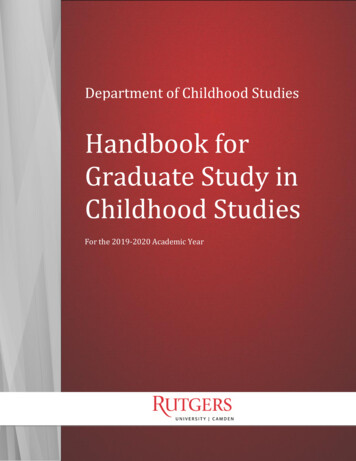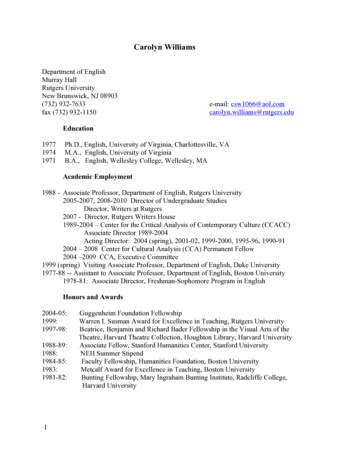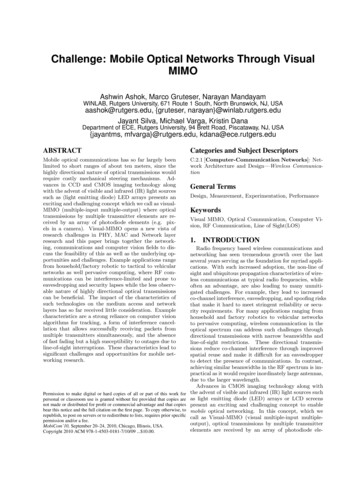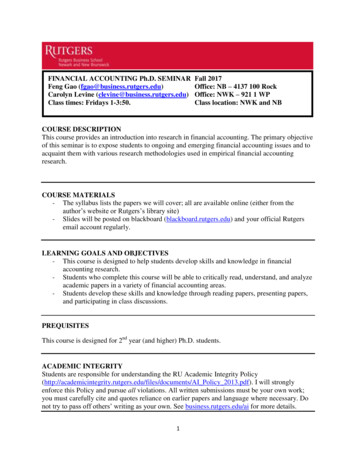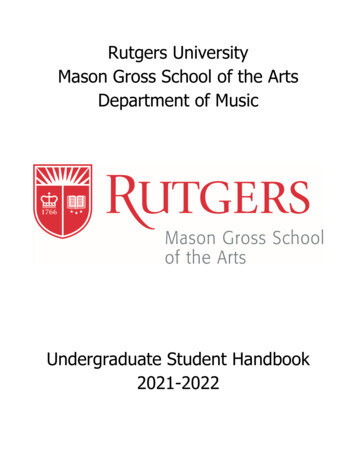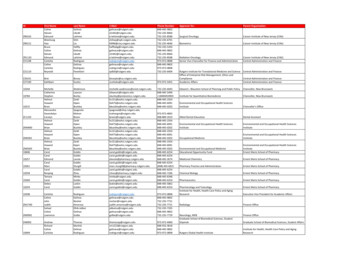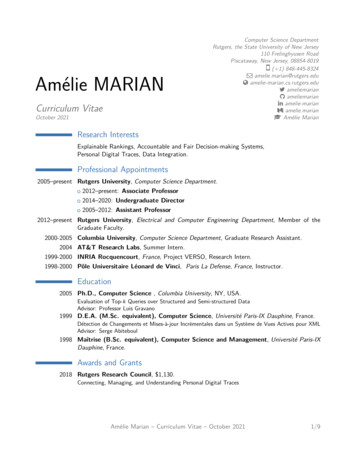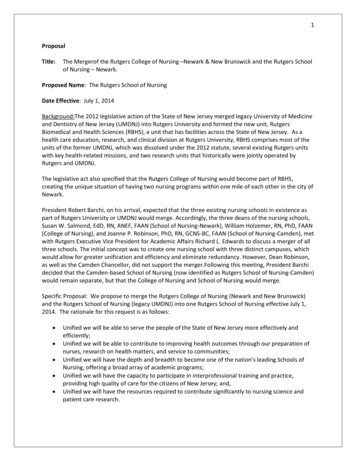
Transcription
1ProposalTitle:The Mergerof the Rutgers College of Nursing –Newark & New Brunswick and the Rutgers Schoolof Nursing – Newark.Proposed Name: The Rutgers School of NursingDate Effective: July 1, 2014Background:The 2012 legislative action of the State of New Jersey merged legacy University of Medicineand Dentistry of New Jersey (UMDNJ) into Rutgers University and formed the new unit, RutgersBiomedical and Health Sciences (RBHS), a unit that has facilities across the State of New Jersey. As ahealth care education, research, and clinical division at Rutgers University, RBHS comprises most of theunits of the former UMDNJ, which was dissolved under the 2012 statute, several existing Rutgers unitswith key health-related missions, and two research units that historically were jointly operated byRutgers and UMDNJ.The legislative act also specified that the Rutgers College of Nursing would become part of RBHS,creating the unique situation of having two nursing programs within one mile of each other in the city ofNewark.President Robert Barchi, on his arrival, expected that the three existing nursing schools in existence aspart of Rutgers University or UMDNJ would merge. Accordingly, the three deans of the nursing schools,Susan W. Salmond, EdD, RN, ANEF, FAAN (School of Nursing-Newark), William Holzemer, RN, PhD, FAAN(College of Nursing), and Joanne P. Robinson, PhD, RN, GCNS-BC, FAAN (School of Nursing-Camden), metwith Rutgers Executive Vice President for Academic Affairs Richard L. Edwards to discuss a merger of allthree schools. The initial concept was to create one nursing school with three distinct campuses, whichwould allow for greater unification and efficiency and eliminate redundancy. However, Dean Robinson,as well as the Camden Chancellor, did not support the merger.Following this meeting, President Barchidecided that the Camden-based School of Nursing (now identified as Rutgers School of Nursing-Camden)would remain separate, but that the College of Nursing and School of Nursing would merge.Specific Proposal: We propose to merge the Rutgers College of Nursing (Newark and New Brunswick)and the Rutgers School of Nursing (legacy UMDNJ) into one Rutgers School of Nursing effective July 1,2014. The rationale for this request is as follows: Unified we will be able to serve the people of the State of New Jersey more effectively andefficiently;Unified we will be able to contribute to improving health outcomes through our preparation ofnurses, research on health matters, and service to communities;Unified we will have the depth and breadth to become one of the nation’s leading Schools ofNursing, offering a broad array of academic programs;Unified we will have the capacity to participate in interprofessional training and practice,providing high quality of care for the citizens of New Jersey; and,Unified we will have the resources required to contribute significantly to nursing science andpatient care research.
2 The School and College offer the same degrees (bachelors, masters, doctor of nursing practice,and PhD). Further, there is significant overlap in course offerings.The Vision: The Rutgers School of Nursing is known for the quality of its faculty, academic programs andalumni; its research, service and educational programs contribute to improving the health and wellbeingof diverse populations and enhancing patient safety and quality across all health care settings.The Mission: To educate students, improve patient care through advancing the discipline of nursingthrough research and scholarship, provide service responsive to the health care needs of multiculturalpopulations; and demonstrate local, national, and international leadership in informing health careoutcomes.This mission reflects the beliefs of the faculty and provides direction to the curricula of thebaccalaureate, the master's, and the doctoral nursing programs, as well as to the continuing educationand Educational Opportunity Fund programs. The School’s mission and goals are congruent with theUniversity's tripartite mission of education, research, and service.Challenges of Merger: The College of Nursing and the Rutgers School of Nursing – Newark utilizeseparate legacy budgeting systems, multiple faculty and staff unions, differences in contractualworkloads, and differences in appointment and promotion criteria. These areas are currently beingaddressed as quickly as possible during this period of transition for the entire university.The two nursing programs have significant commonality in the programs offered to students, clinicalservice projects in the community, and ongoing research activities.The merged School will approximately double the number of students, faculty, and staff in each of thetwo existing entities and be comparable to some of the larger nursing programs such as those at theUniversity of Michigan, Indiana University, and the University of Illinois. Drs. Holzemer and Salmondbelieve that most existing personnel will be needed in the new structure, given the doubling in size ofeach existing program. They anticipate utilizing a budget neutral approach in the first year; they thenwill assess any need for realignment in subsequent years.Merged School OfferingsThe School of Nursing offers a second-career, accelerated baccalaureate program and the College offersthe baccalaureate for generic students, second-career and RN to BSN. The curriculum will beharmonized and these baccalaureate offerings will remain. At the Master’s level, the School of Nursingoffered 12 different Masters Specialties and was in the planning stage of moving 11 of these specialtiesfrom the Master’s level to the Doctor of Nursing Practice (DNP) level. The College of Nursing had only 1master’s specialty, having already moved forward in progressing the advanced practice specialtyprograms from the MSN to DNP level. It was agreed upon that the new merged school would offer theDNP for students entering Advanced Practice Programs. The figure below summarizes the degreeprograms that will be offered by the merged School of Nursing effective July 1, 2014.
3Academic degree programs offered by merged School of Nursing (legacy UMDNJ) andCollege of Nursing, effective July 1, 2014Entry to PracticeProgramsGeneric BSNAccelerated BSNRN to BSN(Baccalaureate)DNP (MS) Specialties/Advanced PracticeDNP Programs(post BS/BSN)PNPANP/GNP Primary CareANP/GNP Acute CareFNPFNP/ERLeadershipWomen’s HealthPsych/Mental HealthPhD ProgramsNursing ScienceUrban HealthSystemsPost-Master DNP ProgramsLeadershipOn-lineExecutive ProgramClinical (e.g. Psych/Mental Health)MS Programs:MidwiferyNurse AnesthetistLeadership-ManagementInformaticsAreas of SubSpecialization*HIV/AIDSTeach-out only –no new mary of Work to Date: Faculty members have been actively involved in the restructuring process.Three initial committees (see appendix) were formed around the major degree programs (BSN, MSN, &DNP). These committees, composed of the administrative head of the program and faculty, werecharged with harmonizing the program plans (admission criteria and courses required for the degree) sothere would be one curriculum plan for each degree program.Concurrently a joint two-day strategic planning retreat was planned for October 2013. Participating inthe retreat were 119 faculty and administrators, and select senior staff from both programs. At this timefaculty were updated on the work of the “harmonizing committees”, explored a vision for the futuremerged school, and brainstormed potential governance structure models and infrastructure needs forschool excellence.Immediately following the retreat, task forces (see Appendix) were formed to begin the harmonizingwork for each course. Forty four taskforces (targeting each course in the BSN, MSN and DNP programs)
4composed of faculty from both the College and School were charged with aligning the courses so therewould be new agreed upon course descriptions, objectives, outcomes, and topical outlines. Thetaskforces were asked to submit their recommendations back to the original program harmonizingcommittee in order to be moved forward for full faculty approval.The first joint faculty meeting was held in January 2014 at which time faculty voted on the proposalsbrought forth by the program level harmonizing committees. This included revised admission criteria,program level objectives and outcomes and program plan course changes for the baccalaureate,masters, and doctor of nursing practice programs. Each item was brought forward for discussion andvote. Faculty voted to adopt the harmonized curriculum plan. The votes and recording of the voteswere performed separately by the two faculty since the schools have not officially merged. A jointcurriculum committee (see Appendix) was agreed upon to facilitate approval of the harmonized courses.Background information for each degree program and the progress to date on curricula integration aredescribed below.Baccalaureate: The College of Nursing has a large generic baccalaureate program and a small 2nd degreeprogram. The 2nd degree students at the College are integrated into the generic courses. The School hasa large 2nd degree program and does not offer the generic program.A joint baccalaureate committee met informally in the Fall of 2012 and officially in January of 2013. Thecommittee was charged with harmonizing the curricula. To date the following have been achieved: Revised admission requirements: recommended by the baccalaureate harmonizationcommittee. Faculty members from both programs have voted to approve the new admissioncriteria.o Added prerequisite courses: interprofessional communication, nutrition, and lifespangrowth and developmento Changed required GPA from 3.0 to 3.3 (3.3 was the mean score of UMDNJ BSN admits andthe requirement for College of Nursing). Joint committee recommendations regarding 2nd degree program:o The 2nd degree baccalaureate program should be a distinct cohort of students and notintegrated with generic students.o The 2nd degree program should be offered on both the Newark and New Brunswickcampuses. Admissions are now being accepted for 2nd degree bachelors students for bothcampuses. Course Plan: The overall course plan for the generic and 2nd degree programs are similar. LegacyUMDNJ had 17 courses and College of Nursing had 15 courses.o A joint faculty committee recommended the elimination of one legacy UMDNJ course withintegration of that content into two other courses. This was voted upon by both faculties and approved.o The program plans for the generic and 2nd degree programs vary slightly with a 62 and 61course credit load. For the 2nd degree program, 62 credits are dispersed across 16 courses.For the generic program, 61 credits are dispersed across 15 courses. This will remain theprogram plan until a complete curriculum revision can be undertaken by faculty.
5 Courses: At the baccalaureate level (both 2nd degree and generic): A joint committee of facultywas formed for each of the 15 overlapping courses. Committees were charged with reviewingand “harmonizing” the Title, Course Description, Course Objectives and Course Outcomes.o The purpose of the harmonization was not to do a full curriculum revision but for there tobe dialog and agreement among faculty as to how the courses from both programs can beslightly adapted so that common syllabi can be shared.o The joint faculty committees have completed reviews of all of the courses and maderecommendations for revisions. The proposed revisions are currently being reviewed by a joint curriculum committee. Voting on the courses began at the separate faculty meetings in February and come tofull faculty in March. After approval by the joint curriculum committee, the revised syllabi will be voted uponat a joint March faculty meeting.Impact: There will be a teach-out of the old curriculum by both the School of Nursing and theCollege of Nursing. New course syllabi will be used beginning Fall 2014. This will be totallyseamless by students as the changes are not content-specific.Masters: NP Programs: Legacy UMDNJ School of Nursing offered nurse practitioner (NP) programsprimarily at the Master’s degree level. Rutgers College of Nursing offers the same NP programs,but at the DNP level. Legacy UMDNJ School of Nursing had plans to transition these programsto the DNP level in one-two years. Consequently, the decision was made that the merger wouldbe an ideal time to make this move.o The existing website clearly indicates that these masters programs are transitioning to theDNP.o The last admissions to the nurse practitioner masters programs was for the Spring 2014term. Remaining Masters level programs:o Informatics: the curriculum remains the same. This program was only offered by the Schoolof Nursing.o Midwifery: will admit an MSN cohort for Fall 2014 and transition to the DNP level for the2015-16 academic year.o Anesthesia: will admit an MSN cohort for Fall 2014 and transition to the DNP level for the2015-16 academic year.Doctor of Nursing Practice: Admission Requirements: The harmonization committee examined the admission requirementsfor the DNP from both schools. Recommendations for changes included: eliminate therequirement for GRE (was a college requirement), reduce the number of letters of referencefrom three to two, and recommend an interview for students with GPAs 3.25 and 3.0.o The admission requirement changes were presented at a joint faculty meeting andapproved. Core Course Plan: Both the College of Nursing and School of Nursing have existing DNPprograms, with some similarities. A joint committee from the School and College examined thecore courses and made recommendations for changes to the DNP Core.o The revised DNP Core plan was presented to the joint faculty in January 2014 and the Coreplan was approved by both faculty groups.
6oStudents currently in the program will be taught out with their respective core requirementon admission. Students entering in fall of 2014 will have a curriculum plan based on the newCore. Course Changes: A harmonization committee consisting of faculty from the School and Collegewas formed for each course at the DNP level.o The committees have completed their work and submitted revised courses.o The courses are being reviewed at the curriculum committee level. Voting on the courses began at the separate faculty meetings in February andcome to full faculty in March.Faculty will vote on these merged programs and common curricula in faculty meetings to be heldmonthly through May.Both the School of Nursing and College of Nursing are currently accredited by the Commission onCollegiate Nursing Education (CCNE), which documents that both schools meet all the standards set bythe accrediting body. The new curricula will meet all CCNE requirements.Administrative CoordinationWhile the faculty was focused on the work of the curriculum, the Deans, admissions officers from bothschools, Academic Affairs and the Registrar met to develop the details of student admission through asingle portal, a common application, office hours, open houses, marketing, application deadlines, etc.The goal is to have a user-friendly system for students, faculty, and staff although the programscurrently operate on different systems. A plan has been put in place.Administrative StructureAt the joint faculty meeting a draft of a faculty and administrative structure was brought forward to thefaculty. The structure brought forward was an adaptation of one of the structures proposed by workingfaculty groups at the October 2013 strategic planning session. It organized the faculty and administrativestructure around divisions according to how nursing practice is conceptualized.A draft of the structure is presented below. This structure continues to be adapted as discussion aboutbest structure is ongoing.
7Rutgers College of NursingADMINISTRATIVE ORG CHARTRev: 2014-01-06AdministrativeSupport OfficeDeanBoard of OverseersExecutiveVice DeanAssociate Dean,Entry to NursingPractice, Director,BSN ProgramInstitute forLearning andInnovationCenter forProfessionalDevelopmentProgram DirectorsGenericAcceleratedRN to BSNBlackwoodHonors ProgramProgram StaffPTL/Adjunct Coord.Course CoordinatorProgram AssistantAssociate Dean,AdvancedNursing PracticeDirector, DNPProgramAssociate Dean,Student ServicesSpecialty DirectorsMidwiferyNurse AnesthetistPNPANP/GNP Primary CareANP/GNP Acute CareFNPFNP/ERWomen’s HealthPsych/Mental HealthPost-Masters DNPMS onSpecialization:HIV/AIDSProgram StaffPreceptor CoordinatorDirector, Faculty Practice/Services, ProgramAssistantAssociate Dean,Global HealthAssociate Dean,Nursing ScienceDirector,Office ofContracts &GrantsDirector,PhDProgramFiscal Services/Business ManagerHuman Resources& Staff ServicesCentersCenter for Community-Based ParticipatoryResearch for Community HealthCenter for Patient Safety & QualityCenter for Women's & Children's HealthCenter for Urban HealthFXBJoanna Briggs Center for KnowledgeSynthesesWorkforce Collaborating Center for NursingAcademic IntegrityAdmissionsClearance for Clinical EducationEOFEvent PlanningFinancial AidAssociate Dean,Administration,Chief ent AcademicSupportStudent ConductStudents LeadershipFaculty ServicesITDevelopmentPublic RelationsSite Managers
10Faculty: Currently, the School of Nursing operates with three departments and the College of Nursingoperates as a department of the whole. At the joint faculty retreat and subsequent joint facultymeeting, different options on how to organize the faculty were considered and discussed.We have developed a faculty structure that flows from the organizational structure for the new entitythat will go into effect on July 1, 2014.Rather than adopt a departmental structure, we propose to adopta structural or programmatic organizational structure. The school will function in three major areas:Entry to Baccalaureate Nursing Education, Advanced Practice Nursing, and Nursing Science. Facultymembers have voted on and approved this structure.Faculty CouncilDivision of Entryto Nursing PracticeDivision ofAdvancedPractice NursingDivision ofNursing ScienceFaculty in the merged school will be placed within one of the divisions. To make the determination ofwhich division a faculty member will be placed in, the faculty will be asked to prioritize their first andsecond choice according to their interest and primary area of teaching responsibility. Assignments willbe subsequently made by the Dean based on faculty choice, faculty expertise, and program needs.Faculty will be assigned to a particular division but may be asked to teach across programs.The Faculty Council is anticipated to become the faculty voice within the merged School of Nursing. Theby-laws will be developed to describe the selection of Faculty Council members from each division. TheAssociate Dean and Director of Student Services from the College of Nursing and the Senior AssociateDean for Academic Affairs and Administration from the School of Nursing have been tasked with staffing
10a joint bylaws committee. To this end, a draft combined bylaws will brought forward to a joint facultybylaws committee for discussion and revision. The draft will be moving to the committee level no laterthan March 24, 2014.The new School of Nursing will be operating for the foreseeable future with two separate facultycontracts, the AAUP-AFT agreement for the legacy Rutgers faculty, and the AAUP agreement for thelegacy UMDNJ faculty. This situation will continue until the issue has been resolved at the Universitylevel. School leadership and faculty believe that the contracts are sufficiently similar to prevent this frombeing a concern. Teaching loads will come from the nature of the faculty appointment or title. Length ofcontract will follow academic program considerations. It is planned that faculty holding a calendar yearappointment will continue with this model. Requests for movement from a calendar year to 10 monthcontract will be considered. Drs. Holzemer and Salmond will work with faculty members, academicaffairs, and union representatives to administratively manage differences. For assignment of newly hiredfaculty, guidance will be provided by the legacy of the vacancy, with decisions made on a case-by-casebasis as needed. RBHS is developing standardized appointment, reappointment, and promotionsprocedures for all RBHS schools, consistent with Rutgers procedures, which will go into effect in 201415.Faculty ProfileProfile of the combined faculty by titles in the Rutgers School of Nursing on July 1, 2014.Total Faculty: N 103 (effective July 1, 2014)Tenured/Tenure Track (N 37; 36%)Distinguished Professor (n 3)Professor (n 7)Associate Professor (n 5; tenured)Associate Professor (n 4; non-tenured)Assistant Professor (n 18)Non-tenure/Clinical Track (n 66; 64%)Clinical Professor (n 5)Clinical Associate Professor (n 10)Clinical Assistant Professor (n 31)Clinical Instructor (n 20)Part-time lecturers (PTL, College of Nursing) and adjunct faculty (School of Nursing) are importantcomponents of the faculty in both programs. The number of PTLs/adjuncts varies by term but,generally, it is estimated that there are approximately twice the number of PTLs/adjuncts as full-timefaculty.All PTLs and adjunct faculty are at least MS-prepared nurses currently working in practice within ahealthcare organization that agrees to take up to ten students for a clinical experience in a topical areasuch as medical-surgical nursing or pediatrics. PTLs and adjunct faculty are clinically competent andcurrent and provide extremely important clinical training for students.Proposed Name and Location:We propose the name Rutgers School of Nursing, in order to be parallel tothe Schools of Medicine, Pharmacy, Dentistry, etc. We recognize that there is a Rutgers-Camden Schoolof Nursing.The new school will be housed in both Newark (on the RBHS campus and the Newark Campus) and NewBrunswick. In fact, a charge to the new school by President Barchi and Executive Vice President Edwardshas been to grow the presence of the program in New Brunswick.The generic baccalaureate programhas been offered on both campuses and will continue to be offered. A new 2nd degree baccalaureate
10program will be offered on the New Brunswick campus. Options for additional space in New Brunswickare currently being examined to meet the expansion needs. Applications are currently being accepted.Student ProfileTotal Students: N 1,834 (effective December 18, 2013)College of Nursing51721247776Grand Total: 1,834(Stratford students not included)UndergraduatesGraduates MS/DNPPhDTotalSchool of Nursing264749481,058Costs: We anticipate a revenue neutral transition as faculty and staff numbers will be similar to what wehave now. However, we are confident that both programs have adequate reserves to manage allunanticipated costs.Policies and Procedures:We are working with all units of Rutgers University as they merge various policies and procedures thatdeal with faculty appointment and promotion, staff union issues, academic calendars, payroll systems,faculty contracts, student integrity policies, faculty integrity policies, and others.We are also working on merging many other areas of work that include, but are not limited to:Combining two alumni associationsCombining two honor societies for nursing (Sigma Theta Tau, International)Recruitment activities for students and facultyEvent planningEnrollment planningDevelopment and fund and friend raisingThis change will require a substantive change document submitted to the 3 accrediting agencies. Thiswill be completed prior to the July 1, 2014 deadline.Prepared by:William L Holzemer, RN, PhD, FAAN, Dean, College of NursingSusan Salmond, RN, EdD, FAAN, Dean, School of Nursing – Newark.March 17, 2014
would remain separate, but that the College of Nursing and School of Nursing would merge. Specific Proposal: We propose to merge the Rutgers College of Nursing (Newark and New Brunswick) and the Rutgers School of Nursing (legacy UMDNJ) into one Rutgers School of Nursing effective July 1, 2014. The rationale for this request is as follows:
